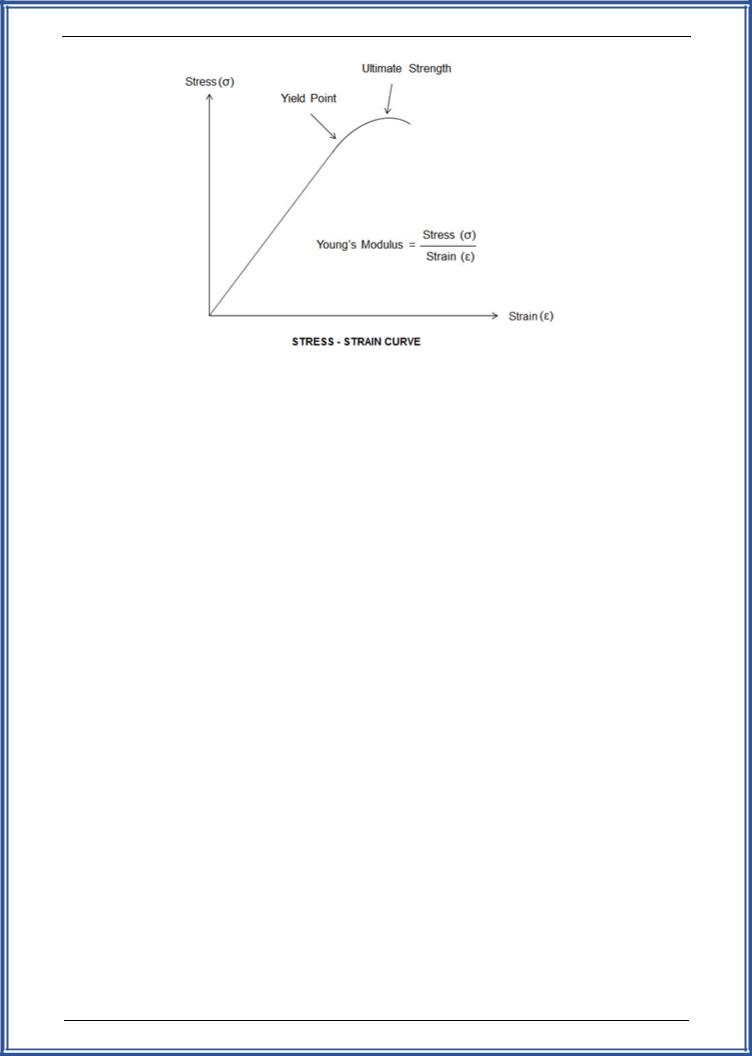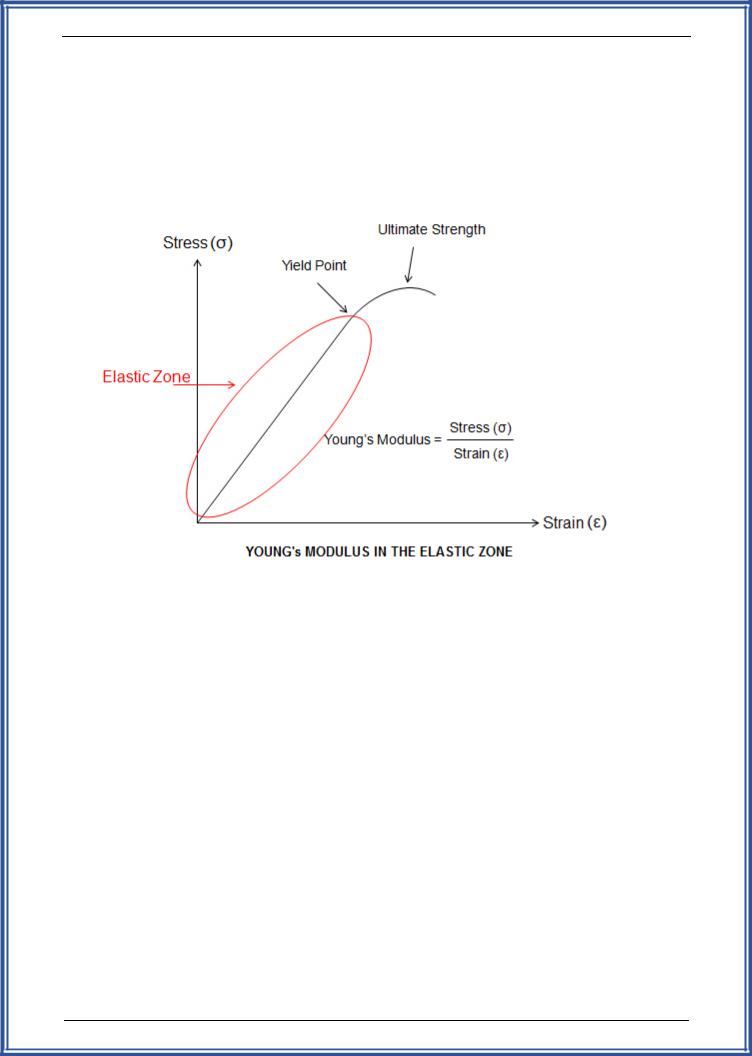
- •CHAPTER - 1
- •PIPING MATERIAL SELECTION & CHARACTERISTICS
- •1. Pipe Material Selection
- •1.1. Selection Criteria
- •1.1.1. Service Life
- •1.1.2. Code Requirements
- •1.1.3. Allowable Stresses
- •1.1.4. Design Temperature
- •1.1.5. Design Pressure
- •1.1.6. Corrosion
- •1.1.7. Economics
- •1.2. Characteristics of Piping Materials
- •1.2.1. Strength
- •1.2.2. Young’s Modulus (Modulus of Elasticity)
- •1.2.3. Stress-Strain Curve
- •1.2.4. Yield Point or Yield strength
- •1.2.5. Ultimate strength
- •1.2.6. Modulus of Elasticity
- •1.2.7. Ductility
- •1.2.8. Malleability
- •1.2.9. Hardness
- •1.2.10. Brittleness
- •1.2.11. Toughness
- •1.2.12. Creep
- •MATERIALS – METALLIC PIPING
- •2. METALLIC PIPES
- •2.1. Piping Material Specifications – ASME/ASTM
- •2.2. ASTM Material Designation
- •2.3. Pipe Grades
- •2.4. Carbon Steel (CS) Pipes
- •Characteristics
- •Applications
- •Standards
- •2.5. Killed Carbon Steel Pipes
- •2.6. Alloy Steel Pipes
- •2.6.1. Low Alloy Steel Characteristics
- •Standards - Pipes
- •2.6.2. High Alloy Steel Characteristics
- •2.7. Chromium Steel Pipes
- •2.8. Stainless Steel Pipes
- •2.8.1. Categories of stainless steels
- •2.8.2. Austenitic Stainless Steels
- •2.8.3. Ferritic Stainless Steel
- •2.8.4. Duplex and Super Duplex Steel
- •2.8.5. Martensitic Stainless Steels
- •2.8.6. Precipitation Hardening Stainless Steel
- •2.9. Cast Iron (CI) Pipes
- •2.10. Nickel and Nickel Alloys
- •2.11. Titanium
- •2.12. Zirconium
- •Some of the common service applications of Zirconium Piping include:
- •2.13. Chrome - Moly
- •2.14. Brass
- •2.15. Aluminium
- •2.16. Copper
- •2.17. Boiler and Heater Tubes
- •CHAPTER - 3
- •SPECIAL PIPING MATERIALS
- •3. PIPING MATERIALS FOR SPECIAL APPLICATIONS
- •3.1. Piping for High Temperature Service
- •3.2. High Temperature Materials
- •3.4. Cold Temperature Materials
- •3.6. Piping for Hydrocarbon Service
- •3.7. Typical Piping Specifications for Various Hydrocarbon Services
- •3.7.2. Sour Water Services
- •3.7.3. Hydrogen Exposure
- •3.7.4. Offshore Environment
- •3.7.5. Sulfides, Sulfurous Gases & Sulfur Environment
- •3.7.6. Oxidation
- •3.7.7. Halogenation Environments
- •3.7.8. Carburizing Environments
- •3.7.9. Nitriding
- •3.7.10. Amine Environment
- •3.7.11. Caustic Environment
- •3.7.12. Corrosion by Acids
- •3.7.13. Corrosion by Salts
- •3.7.14. Chloride Environment
- •3.7.15. Water Corrosion
- •3.7.16. Microbiological Induced Corrosion (MIC)
- •3.8. Applications for Cooling Water and Fire Water Systems
- •3.9. Measures for Corrosion Protection
- •3.9.1. External Corrosion Protection
- •3.10. Material Traceability
- •3.11. Material Test Reports (MTR)
- •3.12. Quality Assurance (QA)
- •3.13. Material Certificates
- •MATERIALS – UNDERGROUND PIPING
- •4. BURIED PIPING
- •4.1. Ductile Iron Pipe
- •4.2. Plastic Pipes
- •4.3. Types of Plastic Pipes
- •4.3.1. Thermoplastics
- •4.3.2. Thermoset Plastics
- •4.4. PVC Pipes
- •4.5. ABS (Acrylonitrile Butadiene Styrene)
- •4.6. Polypropylene (PP) Pipe
- •4.7. Polyethylene (PE) Pipe
- •4.8. PTFE (TEFLON) and PFA Pipe
- •4.9. Plastic Pipe Terminology
- •4.10. Plastic Pipe Designation
- •4.11. Standard Diameters
- •4.12. Dimension Ratio (DR)
- •4.12.1. Standard Dimension Ratio (SDR)
- •4.13. Pressure Rating
- •4.15. Plastic Pipe Standards
- •4.16. HDPE v/s PVC
- •4.17. Standard Sizes
- •4.18. Standard Lengths
- •4.19. Lined Piping
- •4.20. Cost Comparisons

Process Piping Materials – Module 2 – M06-036
1.1.7. Economics
Economics is important. In many occasions, the possibility of usage of inferior materials with periodic replacement is beneficial against the usage of superior material, without sacrificing the safety of the plant.
Two methods readily available to increase corrosion resistance are lowering the carbon content of the material and reducing the instances of unprotected piping.
1.2.Characteristics of Piping Materials
The most important considerations in evaluating various pipe system materials are the strength, ductility, toughness, and corrosion resistance.
1.2.1. Strength
The strength of a material is defined by:
1.Modulus of elasticity
2.Yield strength
3.Ultimate tensile strength
There are two terminologies which need to be understood first.
•Stress (σ)
−Stress (σ) is equal to force divided by the cross sectional area of the material (F/A).
Stress (σ) = F/A
•Strain (ε)
−Strain (ε) is a change of the material per an original length. From the definition, it equals to ∆L/L.
Strain (ε) = ∆L/L
7

Process Piping Materials – Module 2 – M06-036
1.2.2. Young’s Modulus (Modulus of Elasticity)
Young’s modulus (the tensile modulus or elastic modulus) is a ratio of stress and strain along the axis and we can write into the following equation.
Young’s modulus = Stress (σ) ÷ Strain (ε) = (F x L) ÷ (∆L x A)
Where;
•F is pulling force.
•L is an original length of pipe.
•∆L is an amount by which the length of the pipe changes.
•A is a cross sectional area of object.
The Young’s Modulus of material represents the factor of proportionality in Hook’s Law; therefore, it will be valid under the elastic zone. Young’s Modulus is expressed in Pound per Square Inch (psi) in US customary unit and N/m2 (Newton) in SI units.
1.2.3. Stress-Strain Curve
A stress-strain curve is a graph derived from Stress (σ) versus Strain (ε) for a sample of material.
8

Process Piping Materials – Module 2 – M06-036
1.2.4. Yield Point or Yield strength
Yield Point or Yield strength is defined as the stress at which a material begins to plastically deform. Before the yield point the material will deform elastically and it will return to its original shape when the stress is released. If the tension applied is over the yield point, the deformation will be permanent and non-reversible.
1.2.5. Ultimate strength
Ultimate strength is the maximum stress applied before the material is completely parted. As the load is increased beyond the yield strength, its cross-sectional area will decrease until the point at which the material cannot handle any further load increase. The ultimate tensile strength is that load divided by the original crosssectional area.
1.2.6. Modulus of Elasticity
Elasticity is a property by virtue of which a material deformed under the load can regain its original dimensions when unloaded. This property is utilized in piping system designs where pipes may expand or contract due to temperature differences.
Young’s Modulus (modulus of elasticity)
Young’s Modulus (modulus of elasticity) is the slope of the Stress-Strain curve within the elastic limit (see the figure below).
Where the ratio is linear through a range of stress, the material is elastic; i.e. the material will return to its original, unstressed shape once the applied load is removed.
9

Process Piping Materials – Module 2 – M06-036
If the material is loaded beyond the elastic range, it will begin to deform in a plastic manner.
It means that once tensile is less than Yield Point, the Young’s Modulus is valid for the calculation.
Young’s Modulus of steel is 30 x 106 psi.
All of these properties are determined using ASTM standard test methods.
1.2.7. Ductility
Ductility is defined as the amount of plastic deformation that a material undergoes in resisting the fracture under stress. Ductile metals lend themselves to be formed into desired cross-sectional shapes easier and therefore are cheaper to manufacture. Ductility is commonly measured by either the elongation in a given length or by the reduction in the cross-sectional area when subjected to an applied load.
1.2.8. Malleability
Malleability is defined as the property of a metal to be deformed by compression without cracking or rupturing. This property is very useful for copper tubing systems, which allows the tube to be bent to follow the required route quickly without the need for expensive and time consuming fittings.
10
